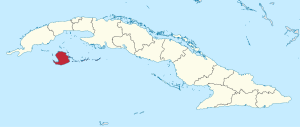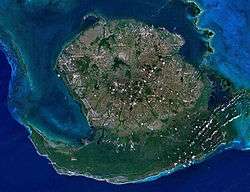Isla de la Juventud
Coordinates: 21°45′N 82°51′W / 21.750°N 82.850°W
| Isla de la Juventud | ||
|---|---|---|
| Special Municipality of Cuba | ||
| ||
 | ||
| Country | Cuba | |
| Capital | Nueva Gerona | |
| Area[1] | ||
| • Total | 2,419 km2 (934 sq mi) | |
| Population (December 31, 2010)[1] | ||
| • Total | 86,420 | |
| • Density | 36/km2 (93/sq mi) | |
| Time zone | EST (UTC-5) | |
| Area code(s) | +53-061 | |

Isla de la Juventud[2] (Spanish pronunciation: [ˈizla ðe la xuβenˈtuð]; English: Isle of Youth) is the second-largest Cuban island and the seventh-largest island in the West Indies (after Cuba itself, Hispaniola, Jamaica, Puerto Rico, Trinidad, and Andros Island). The island was called the Isle of Pines (Isla de Pinos) until 1978. It has an area 2,200 km2 (850 sq mi) and is 50 km (31 mi) south of the island of Cuba, across the Gulf of Batabanó. The island lies almost directly south of Havana and Pinar del Río and is a Special Municipality (2,419 km2 (934 sq mi)), not part of any province and is therefore administered directly by the central government of Cuba. The island has only one municipality, also named Isla de la Juventud.
The largest of the 350 islands in the Canarreos Archipelago (Archipiélago de los Canarreos), the island has an estimated population of 100,000. The capital and largest city is Nueva Gerona in the north, and the second-largest and oldest city is Santa Fe in the interior. Other communities include Columbia, La Demajagua (formerly Santa Bárbara),[3] Mac Kinley, Cuchilla Alta, Punta del Este, Sierra de Caballos and Sierra de Casas.
History
Little is known of the pre-Columbian history of the island, though a cave complex near the Punta del Este beach preserves 235 ancient drawings made by the native population. The island first became known to Europeans in 1494 during Christopher Columbus's second voyage to the New World. Columbus named the island La Evangelista and claimed it for Spain. The island was also known as Isla de Cotorras (Isle of Parrots) and Isla de Tesoros (Treasure Island) at various points in its history.
Pirate activity in and around the area left its trace in English literature. Both Treasure Island by Robert Louis Stevenson and Peter Pan by J. M. Barrie draw on accounts of the island and its native and pirate inhabitants, as well as the long dugout canoes that both pirates and the indigenous peoples used and the American crocodile (Crocodylus acutus).
Following its defeat in the Spanish–American War and the Cuban War of Independence, Spain dropped all claims to Cuba under the terms of the 1898 Treaty of Paris. The Platt Amendment of 1901, which defined Cuba's boundaries for the purposes of U.S. authorities, left the ownership of Isla de la Juventud undetermined. This led to competing claims to the island by the United States and Cuba.[4] In 1907, the U.S. Supreme Court decided, in Pearcy v. Stranahan, that control of the island was a political decision, not a judicial one.[5] In 1916, a pamphlet titled "Isle of Pines: American or What?" called for the U.S. to annex or purchase the island to settle the issue.[6]
In 1904, Cuba and the United States negotiated and signed the Hay-Quesada Treaty, which recognized Cuba's ownership of the island. The U.S. Senate ratified this agreement on March 13, 1925, over the objections of some four hundred United States citizens and companies, who owned or controlled about 95% of the island's land.[7][8]
Fidel Castro presided at a ceremony changing the name of the island from Isla de Pinos to Isla de la Juventud on 3 August 1978.[9] This was the realization of a promise that he had made in 1967, when he said, “Let’s call it the Isle of Youth when the youth have done something grand with their work here, when they have revolutionized the natural environment, when they see the fruits of their labor and have revolutionized society here.”[10]
Geography and economy
Much of the island is covered in pine forests, which is the source of the island's large lumber industry. The northern region of the island has low ridges from which marble is quarried, while the southern region is an elevated plain. Agriculture and fishing are the island's main industries, with citrus fruit and vegetables being grown. A black sand beach was formed by volcanic activity.
The island has a mild climate, but is known for frequent hurricanes. It is a popular tourist destination, with many beaches and resorts, including Bibijagua Beach. Until the Cuban government expropriated all foreign-owned property in the early 1960s, much land was owned by Americans, and the island contained a branch of the Hilton Hotels chain.
Demographics
In 2004, the Special Municipality of Isla de la Juventud had a population of 86,637.[11] With a total area of 2,419.27 km2 (934.09 sq mi),[12] the Municipality had a population density of 35.8/km2 (93/sq mi).
Transportation
The main transportation to the island is by boat or aircraft. Hydrofoils (kometas) and motorized catamarans will make the trip in between two and three hours. A much slower and larger cargo ferry takes around six hours to make the crossing, but is cheaper.
Prisons
In 1926, Cuba erected a model penitentiary of panopticon design on the outskirts of Nueva Gerona, Presidio Modelo, 1926 and 1928.[7] Cuban leader Fidel Castro, after leading the failed attack on the Moncada Barracks July 1953, was imprisoned in it from 1953 to 1955 by the regime of Fulgencio Batista, as was his brother Raul.[13] Following the Cuban Revolution, the same facility was used to imprison the new regime's enemies and political dissidents. They included Huber Matos, an officer in the revolutionary army who attempted to resign and who said he was tortured there,[14] and Armando Valladares, who wrote a memoir describing the prison's harsh conditions and cruel treatment of prisoners of conscience and political prisoners.[15]
Presidio Modelo ceased functioning as a prison in 1967. It has been declared a national monument and its hospital rooms converted into a museum. It functions are now carried out in more modern facilities, including one minimum security prison (Prison El Guayabo) and four correctional facilities: Center for Reeducation of Minors, Correctional Los Colonos, Paquito Rosales Cueto (1 y 11), and Prison la 60 (Columbia)
Image gallery
 Esperanza Ranch in 1914
Esperanza Ranch in 1914 Christmas Eve, Isle of Pines in 1910
Christmas Eve, Isle of Pines in 1910
Notes
- 1 2 "Lugar que ocupa el territorio según la superficie y la población" (PDF). Una MIRADA a Cuba (in Spanish). Oficina Nacional de Estadísticas. Cuba. 2010.
- ↑ Directorate of Intelligence (August 16, 2007). "The World Factbook — Cuba". Retrieved September 3, 2007.
- ↑ (Spanish) Historical infos about Santa Bárbara and La Demajagua on EcuRed
- ↑ "The Isle of Pines". New York Times. November 16, 1905. Retrieved November 9, 2013.
The 'secession' from Cuba of a few American residents of the Isle of Pines is an incident of which National good faith and self-respect, we think, will compel the Government at Washington to take, not approving, but adverse notice.
- ↑ Tucker, Spencer C. (2009). The Encyclopedia of the Spanish-American and Philippine-American Wars. Santa Barbara, California: ABC-CLIO. p. 525. ISBN 978-1-85109-951-1.
- ↑ "Would Annex The Isle of Pines". New York Times. August 18, 1916. Retrieved November 9, 2013.
The proposed purchase by the United States of the Danish West Indies for $25,000,000 has started a renewal of agitation by American residents of the Isle of Pines for its purchase or acquisition from Cuba by the United States. The Isle of Pines Chamber of Commerce has issued a pamphlet entitled "Isle of Pines: American or What?"
- 1 2 Ireland, Gordon (1941). Boundaries, possessions, and conflicts in Central and North America and the Caribbean. New York: Octagon Books. p. 333.
- ↑ Cuba's Island of Dreams: Voices from the Isle of Pines and Youth
- ↑ "Cuba has New Name for 'Treasure Island'". New York Times. 4 August 1978. Retrieved 11 April 2016.
- ↑ Gonzalez Suarez, Lisanka. "History and present state of Isla de la Juventud Cuba". Havana Journal Inc. Retrieved 22 September 2016.
- ↑ Atenas.cu (2004). "2004 Population trends, by Province and Municipality" (in Spanish). Archived from the original on September 27, 2007. Retrieved October 2, 2007.
- ↑ Government of Cuba (2002). "Population by Special Municipality" (in Spanish). Retrieved October 2, 2007.
- ↑ von Tunzelmann, Alex (2011). Red Heat: Conspiracy, Murder and the Cold War in the Caribbean. London: Simon & Schuster. Retrieved January 17, 2016.
- ↑ "Huber Matos, a Moderate in the Cuban Revolution". American Experience. PBS. December 21, 2004. Retrieved January 26, 2011.
- ↑ Armando Valladares, Against All Hope (New York: Knopf, 1986)
External links
| Wikimedia Commons has media related to Isle of Youth. |
- Supreme Court decision of 1907
- Municipality page (Spanish)
- Image of the Presidio Modelo, Léopold Lambert, Weaponized Architecture: The Impossibility of Innocence, New York, 2012, p. 19.